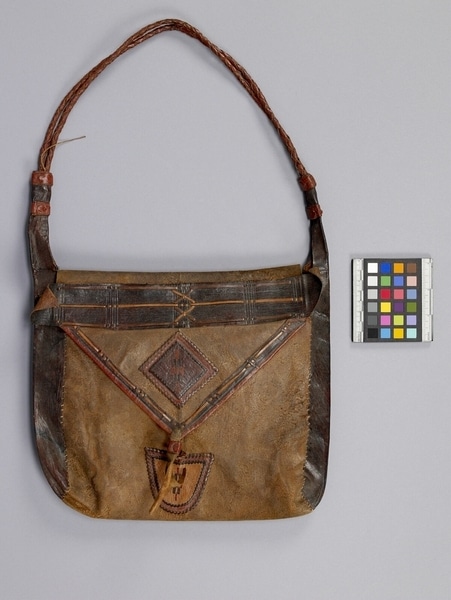Bag Item Number: Cb76 from the MOA: University of British Columbia


Description
A brown leather bag in three main pieces with appliqued, and embroidered leather trim outlining the flap and the front of the bag. Side inserts extend upward to form a sheath into which a double braided strap handle is bound. Front flap fastens with a leather toggle. Design motifs include diamond and cup-shaped cut-outs of decreasing size, crosses, and dot-and-dash lines.
History Of Use
Many varieties of bags and other containers are made by leather workers throughout the Sub-Saharan area of West Africa and are widely traded. The style of embroidery and applique and the use of 'Kano green' are typical of Northern Nigeria. The bag style indicates probable Fulani origins.
Iconographic Meaning
The colour green, significant in Mohammedan ritual, indicates the influence of Islam in Northern Nigeria.
Specific Techniques
The red dyes used for the leather decorations were made from a variety of sorghum (or karan dafi). A watery extract of wood ashes or natron would sit in a bowl for three to four hours; the dyestuff was pulverized in a wooden mortar and mixed with the extract. The tanned hide would be dressed with ground-nut oil or shea butter and then immersed in the mixture for one to two minutes, and then wrung out and shaken. Finally the hide would be rinsed in cold water, which had been acidulated with lime juice and tarmind pulp.
Item History
- Made in Kano, Nigeria ?
- Collected during 1910
- Owned by Norman Lowden
- Owned by Yvonne Adams before August 3, 1976
- Received from Yvonne Adams (Donor) on August 3, 1976
What
Who
- Culture
- Fulani ?
- Previous Owner
- Norman Lowden and Yvonne Adams
- Received from
- Yvonne Adams (Donor)
Where
- Holding Institution
- MOA: University of British Columbia
- Made in
- Kano, Nigeria ?
When
- Collection Date
- during 1910
- Ownership Date
- before August 3, 1976
- Acquisition Date
- on August 3, 1976
Other
- Condition
- good
- Accession Number
- 0321/0003